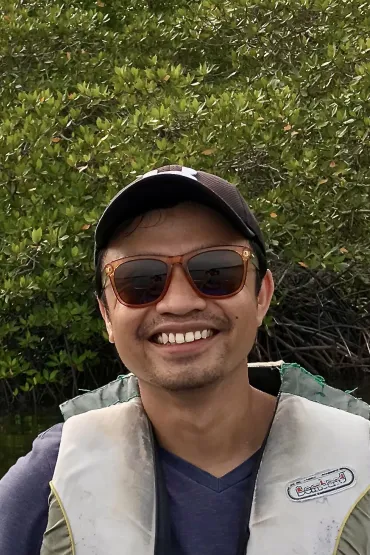Research project title
Mangrove blue carbon dynamics in Papua, Indonesia: effects of hydro-geomorphic setting and land-use change
Abstract
Mangroves are one of the most efficient organic carbon sink ecosystems which occur along intertidal coastal areas of tropical and subtropical regions. Together with other coastal wetlands such as saltmarsh and seagrass, mangroves have been termed ‘blue carbon’ ecosystems due to their substantial capacity for carbon storage and sequestration. Consequently, policymakers and stakeholders promote mangroves for natural-based climate change mitigation. However, many mangroves across the world are being altered by anthropogenic disturbances including land-use and land-cover change (LULCC). Large-scale LULCC will inevitably affect the magnitude and direction (loss or gain) of the carbon cycle in mangroves.
The overarching goal in this study was to assess the dynamics of mangrove carbon stocks for the Papua region of Indonesia. This region supports globally significant mangrove estate due to its large extent (~10% of world’s mangrove area), its conservation status, and its potential carbon storage but with evidence of increasing land-use change. To achieve this goal, this study consisted of: 1) a systematic review and meta-analysis to synthesis current evidence quantifying the effect of LULCC on mangrove blue carbon stocks at global scale; 2) field data collection across a widely distributed site network representative of different numbers of hydro-geomorphic settings and LULCCs to assess carbon stocks as well as their rates of loss and gain over space and time; 3) assess rates of carbon burial and identify their sources.
In summary, this study described that Papuan mangrove holds a substantial asset for national and global blue carbon management, and therefore climate change mitigation policy. In addition, the potential carbon sequestration and other co-benefits that these mangrove ecosystems provide would be lost if high intensity land-use change were to occur across these estates. Findings from this thesis will be essential to guide policymakers and will inform climate change mitigation strategies at both regional and national scales.
Research interests
Dr Sigit Sasmito was awarded his PhD in August 2020. He is a Wetlands Ecologist who has particular research interests to study the impacts of contemporary global change on tropical wetland ecosystems including peatlands and mangrove. Prior to completing his PhD research, Sigit worked as Research Assistant with The Centre for International Forestry Research (CIFOR) in Bogor, Indonesia. Sigit holds a Bachelor of Science in Applied Meteorology from IPB University, Indonesia. Currently, his research is focused to improve current understanding of terrestrial carbon cycle in tropical peatlands using both global scale systematic review approach and landscape-scale field assessment.
Links
https://www.cdu.edu.au/news/news-archive/filling-blue-carbon-knowledge-gaps
https://www.cdu.edu.au/launchpad/research-impact/how-sigit-shaping-indonesian-environmental-policy
https://www.cdu.edu.au/news/national-geographic-grant-help-uncover-blue-carbon
